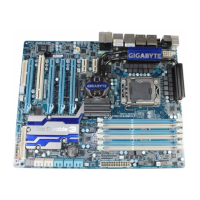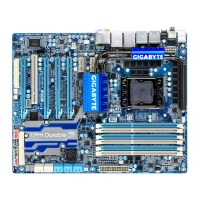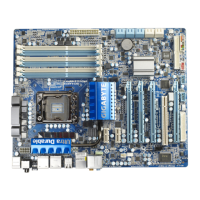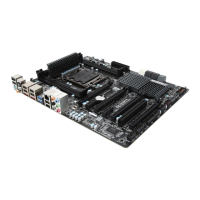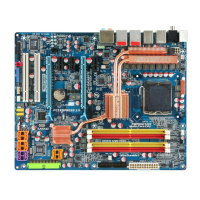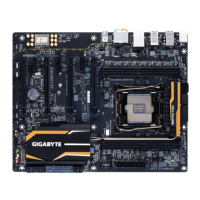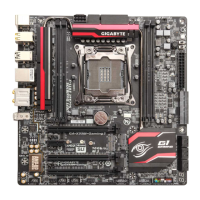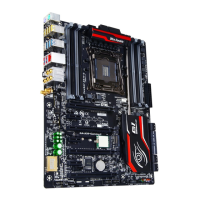Do you have a question about the Gigabyte GA-X58-USB3 and is the answer not in the manual?
Essential safety guidelines and procedures before installing hardware components.
Detailed technical specifications of the motherboard and its components.
Step-by-step guide for safely installing the CPU and its cooling solution.
Instructions on how to install DDR3 memory modules correctly.
Procedures for installing various expansion cards into available slots.
Guide for setting up multi-GPU configurations like CrossFireX and SLI.
Overview of all ports and connectors located on the motherboard's rear panel.
Identification and description of internal headers and connectors on the motherboard.
Screens that may appear during the computer's boot process.
Navigation and overview of the BIOS Setup main menu options.
Advanced settings for CPU, memory, and voltage adjustments for performance tuning.
Configuration of system date, time, and basic hardware settings.
Settings for boot order, system performance, and other advanced features.
Configuration of onboard devices like SATA, USB, LAN, and Audio.
Options for managing system power states and energy saving features.
Monitoring system temperatures, voltages, and fan speeds for hardware health.
Restoring BIOS settings to the safest, most stable factory defaults.
Restoring BIOS settings to optimal factory defaults for performance.
Setting passwords for BIOS access and system startup security.
Saving current BIOS settings and exiting the setup utility.
Guide for installing essential chipset drivers from the motherboard driver disk.
Information on available GIGABYTE utilities and bundled software for installation.
Provides GIGABYTE's application guides and motherboard manuals.
Links and information for downloading the latest BIOS, drivers, and applications.
Utility for quickly backing up and restoring system data.
Instructions for updating the system BIOS using Q-Flash or @BIOS tools.
Software for system tuning, overclocking, and monitoring hardware in Windows.
Technology for optimizing power savings and energy efficiency.
Tool for sharing data with computers on the same network.
Suite of six innovative utilities for system management and performance enhancement.
Tool for creating backups of changed data files or copying files from a backup.
Monitors and records system activities like power on/off times and file copying.
Manages computer usage time with simple rules and options.
Tool for enabling system power savings via a Bluetooth cell phone.
Utility for easy RAID configuration and performance enhancement.
Steps to install, configure SATA controllers, and set up RAID arrays.
Guide for installing RAID/AHCI drivers and the operating system.
Instructions for setting up multi-channel audio configurations and connections.
Frequently asked questions and procedures to resolve common system startup issues.
Official notices regarding product compliance, safety, and environmental regulations.
Essential safety guidelines and procedures before installing hardware components.
Detailed technical specifications of the motherboard and its components.
Step-by-step guide for safely installing the CPU and its cooling solution.
Instructions on how to install DDR3 memory modules correctly.
Procedures for installing various expansion cards into available slots.
Guide for setting up multi-GPU configurations like CrossFireX and SLI.
Overview of all ports and connectors located on the motherboard's rear panel.
Identification and description of internal headers and connectors on the motherboard.
Screens that may appear during the computer's boot process.
Navigation and overview of the BIOS Setup main menu options.
Advanced settings for CPU, memory, and voltage adjustments for performance tuning.
Configuration of system date, time, and basic hardware settings.
Settings for boot order, system performance, and other advanced features.
Configuration of onboard devices like SATA, USB, LAN, and Audio.
Options for managing system power states and energy saving features.
Monitoring system temperatures, voltages, and fan speeds for hardware health.
Restoring BIOS settings to the safest, most stable factory defaults.
Restoring BIOS settings to optimal factory defaults for performance.
Setting passwords for BIOS access and system startup security.
Saving current BIOS settings and exiting the setup utility.
Guide for installing essential chipset drivers from the motherboard driver disk.
Information on available GIGABYTE utilities and bundled software for installation.
Provides GIGABYTE's application guides and motherboard manuals.
Links and information for downloading the latest BIOS, drivers, and applications.
Utility for quickly backing up and restoring system data.
Instructions for updating the system BIOS using Q-Flash or @BIOS tools.
Software for system tuning, overclocking, and monitoring hardware in Windows.
Technology for optimizing power savings and energy efficiency.
Tool for sharing data with computers on the same network.
Suite of six innovative utilities for system management and performance enhancement.
Tool for creating backups of changed data files or copying files from a backup.
Monitors and records system activities like power on/off times and file copying.
Manages computer usage time with simple rules and options.
Tool for enabling system power savings via a Bluetooth cell phone.
Utility for easy RAID configuration and performance enhancement.
Steps to install, configure SATA controllers, and set up RAID arrays.
Guide for installing RAID/AHCI drivers and the operating system.
Instructions for setting up multi-channel audio configurations and connections.
Frequently asked questions and procedures to resolve common system startup issues.
Official notices regarding product compliance, safety, and environmental regulations.
| Non-ECC | Yes |
|---|---|
| Memory voltage | 1.5 V |
| Number of memory slots | 6 |
| Maximum internal memory | 24 GB |
| Supported memory clock speeds | 800, 1066, 1333 MHz |
| Processor socket | Socket B (LGA 1366) |
| Processor manufacturer | Intel |
| USB 2.0 connectors | 3 |
| Number of Parallel ATA connectors | 0 |
| PS/2 ports quantity | 2 |
| USB 2.0 ports quantity | USB 2.0 ports have a data transmission speed of 480 Mbps, and are backwards compatible with USB 1.1 ports. You can connect all kinds of peripheral devices to them. |
| Ethernet LAN (RJ-45) ports | 1 |
| Audio chip | Realtek ALC892 |
| Audio output channels | 7.1 channels |
| Motherboard form factor | ATX |
| Compatible operating systems | Windows 7/Vista/XP |
| On-board graphics card | No |
| Parallel processing technology support | Not supported |
| RAID levels | 0, 1, 10 |
| LAN controller | Realtek RTL8111E |
| Networking features | Gigabit Ethernet |
| ACPI version | 1.0 |
| BIOS memory size | 32 Mbit |
| Depth | 244 mm |
|---|---|
| Width | 305 mm |

